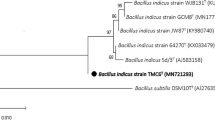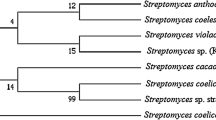Abstract
This study aims to determine UV-B resistance and to investigate computational analysis and antioxidant potential of methoxy-flavones of Micromonospora aurantiaca TMC-15 isolated from Thal Desert, Pakistan. The cellular extract was purified through solid-phase extraction and UV–Vis spectrum analysis indicated absorption peaks at λmax 250 nm, 343 nm, and 380 nm that revealed the presence of methoxy-flavones named eupatilin and 5-hydroxyauranetin. The flavones were evaluated for their antioxidant as well as protein and lipid peroxidation inhibition potential using di(phenyl)-(2,4,6-trinitrophenyl) iminoazanium (DPPH), 2,4-dinitrophenyl hydrazine (DNPH), and thiobarbituric acid reactive substances (TBARS) assays, respectively. The methoxy-flavones were further studied for their docking affinity and interaction dynamics to determine their structural and energetic properties at the atomic level. The antioxidant potential, protein, and lipid oxidation inhibition and DNA damage preventive abilities were correlated as predicted by computational analysis. The eupatilin and 5-hydroxyauranetin binding potential to their targeted proteins 1N8Q and 1OG5 is − 4.1 and − 7.5 kcal/mol, respectively. Moreover, the eupatiline and 5-hydroxyauranetin complexes illustrate van der Waals contacts and strong hydrogen bonds to their respective enzymes target. Both in vitro studies and computational analysis results revealed that methoxy-flavones of Micromonospora aurantiaca TMC-15 can be used against radiation-mediated oxidative damages due to its kosmotrophic nature. The demonstration of good antioxidant activities not only protect DNA but also protein and lipid oxidation and therefore could be a good candidate in radioprotective drugs and as sunscreen due to its kosmotropic nature.








Similar content being viewed by others
Data Availability
Not applicable.
References
Abbasi, S., Raza, S., Azam, S. S., Liedl, K. R., & Fuchs, J. E. (2016). Interaction mechanisms of a melatonergic inhibitor in the melatonin synthesis pathway. Journal of Molecular Liquids, 221, 507–517.
Beblo-Vranesevic, K., Galinski, E. A., Rachel, R., Huber, H., & Rettberg, P. (2017). Influence of osmotic stress on desiccation and irradiation tolerance of (hyper)-thermophilic Microorganisms. Archives of microbiology, 199(1), 17–28.
Berman, H. M., Westbrook, J., Feng, Z., Gilliland, G., Bhat, T. N., Weissig, H., Shindyalov, I. N., & Bourne, P. E. (2000). The protein data bank. Nucleic Acids Research, 28(1), 235–242.
Brettin, T., Davis, J. J., Disz, T., Edwards, R. A., Gerdes, S., Olsen, G. J., Olson, R., Overbeek, R., Parrello, B., Pusch, G. D., & Shukla, M. (2015). RASTtk: A modular and extensible implementation of the RAST algorithm for building custom annotation pipelines and annotating batches of genomes. Scientific Report, 5, 8365.
Carro, L., Castro, J. F., Razmilic, V., Nouioui, I., Pan, C., Igual, J. M., Jaspars, M., Goodfellow, M., Bull, A. T., Asenjo, J. A., & Klenk, H. P. (2019). Uncovering the potential of novel micromonosporae isolated from an extreme hyper-arid Atacama Desert soil. Scientific Report, 9(1), 1–6.
Carro, L., Golinska, P., Nouioui, I., Bull, A. T., Igual, J. M., Andrews, B. A., Klenk, H. P., & Goodfellow, M. (2019). Micromonospora acroterricola sp. nov., a novel actinobacterium isolated from a high altitude Atacama Desert soil. International Journal of Systematic and Evolutionary Microbiology, 69(11), 3426–36.
Case, D. A., Darden, T. A., Cheatham III, T. E., Simmerling, C.L., … Kollman, P.A. (2018). AMBER 18, University of California, San Francisco
Costa, J. D., Ramos, R. D., Costa, K. D., Brasil, D. D., Silva, C. H., Ferreira, E. F., Borges, R. D., Campos, J. M., Macêdo, W. J., & Santos, C. B. (2018). An in silico study of the antioxidant ability for two caffeine analogs using molecular docking and quantum chemical methods. Molecules, 23(11), 2801.
Ebrahimzadeh, M. A., Pourmorad, F., & Hafezi, S. (2008). Antioxidant activities of Iranian corn silk. Turkish Journal of Biology, 32(1), 43–49.
Fredrickson, J. K., Shu-mei, W. L., Gaidamakova, E. K., Matrosova, V. Y., Zhai, M., Sulloway, H. M., Scholten, J. C., Brown, M. G., Balkwill, D. L., & Daly, M. J. (2008). Protein oxidation: Key to bacterial desiccation resistance? The ISME Journal, 2(4), 393–403.
Galano, A., Vargas, R., & Martínez, A. (2010). Carotenoids can act as antioxidants by oxidizing the superoxide radical anion. Physical Chemistry Chemical Physics, 12(1), 193–200.
Hanasaki, Y., Ogawa, S., & Fukui, S. (1994). The correlation between active oxygens scavenging and antioxidative effects of flavonoids. Free Radical Biology and Medicine, 16(6), 845–850.
Heli, H., Mirtorabi, S., & Karimian, K. (2011). Advances in iron chelation: An update. Expert opinion on therapeutic patents, 21(6), 819–856.
Jiao, Y., Cody, G. D., Harding, A. K., Wilmes, P., Schrenk, M., Wheeler, K. E., Banfield, J. F., & Thelen, M. P. (2010). Characterization of extracellular polymeric substances from acidophilic microbial biofilms. Applied and Environmental Microbiology, 76(9), 2916–2922.
Kitts, D. D., Wijewickreme, A. N., & Hu, C. (2000). Antioxidant properties of a North American ginseng extract. Molecular and Cellular Biochemistry, 203(1–2), 1.
Kolnagou, A., Kontoghiorghe, C. N., & Kontoghiorghes, G. J. (2014). Transition of Thalassaemia and Friedreich ataxia from fatal to chronic diseases. World Journal of Methodology, 4(4), 197.
Krinsky, N. I., & Johnson, E. J. (2005). Carotenoid actions and their relation to health and disease. Molecular Aspects of Medicine, 26(6), 459–516.
Kumar, S., Stecher, G., Li, M., Knyaz, C., & Tamura, K. (2018). MEGA X: Molecular evolutionary genetics analysis across computing platforms. Molecular Biology Evolution, 35(6), 1547–1549.
Lee, Y. K., Yuk, D. Y., Lee, J. W., Lee, S. Y., Ha, T. Y., Oh, K. W., Yun, Y. P., & Hong, J. T. (2009). (−)-Epigallocatechin-3-gallate prevents lipopolysaccharide-induced elevation of beta-amyloid generation and memory deficiency. Brain Research, 1250, 164–174.
Li, L., & Hong, K. (2016). Micromonospora ovatispora sp. nov. isolated from mangrove soil. International Journal of System and Evolutionary Microbiology, 66(2), 889–93.
Li, S. J., Hua, Z. S., Huang, L. N., Li, J., Shi, S. H., Chen, L. X., Kuang, J. L., Liu, J., Hu, M., & Shu, W. S. (2014). Microbial communities evolve faster in extreme environments. Scientific Report, 4, 6205.
Mattimore, V., & Battista, J. R. (1996). Radioresistance of Deinococcus radiodurans: Functions necessary to survive ionizing radiation are also necessary to survive prolonged desiccation. Journal of Bacteriology, 178(3), 633–637.
Mehetre, G. T., Vinodh, J. S., Burkul, B. B., Desai, D., Santhakumari, B., Dharne, M. S., & Dastager, S. G. (2019). Bioactivities and molecular networking-based elucidation of metabolites of potent actinobacterial strains isolated from the Unkeshwar geothermal springs in India. RSC Advances, 9(17), 9850–9859.
Miller, B. R., III., McGee, T. D., Jr., Swails, J. M., Homeyer, N., Gohlke, H., & Roitberg, A. E. (2012). MMPBSA. py: An efficient program for end-state free energy calculations. Journal of Chemical Theory and Computation, 8(9), 3314–21.
Morris, G. M., Huey, R., Lindstrom, W., Sanner, M. F., Belew, R. K., Goodsell, D. S., & Olson, A. J. (2009). AutoDock4 and AutoDockTools4: Automated docking with selective receptor flexibility. Journal of Computational Chemistry, 30(16), 2785–2791.
Nair, C. K., Salvi, V., Kagiya, T. V., & Rajagopalan, R. (2004). Relevance of radioprotectors in radiotherapy: Studies with tocopherol monoglucoside. Journal of Environmental Pathology, Toxicology and Oncology, 23(2)
Naz, S., Ahmad, S., Walton, S., & Abbasi, S. W. (2020). Multi-epitope based vaccine design against Sarcoptes scabiei paramyosin using immunoinformatics approach. Journal of Molecular Liquids, 319, 114105.
Prazdnova, E. V., Dem’yanenko, S. V., Chistyakov, V. A., Lysenko, V. S., & Batyushin, M. M. (2014). Carotenoids-antioxidants of D. radiodurans stimulate regeneration in mice. Biology and Medicine, 6(3), 1.
Rainey, F. A., Ray, K., Ferreira, M., Gatz, B. Z., Nobre, M. F., Bagaley, D., Rash, B. A., Park, M. J., Earl, A. M., Shank, N. C., & Small, A. M. (2005). Extensive diversity of ionizing-radiation-resistant bacteria recovered from Sonoran Desert soil and description of nine new species of the genus Deinococcus obtained from a single soil sample. Applied and Environmental Microbiology, 71(9), 5225–5235.
Roe, D. R., & Cheatham III, T. E. (2013). PTRAJ and CPPTRAJ: Software for processing and analysis of molecular dynamics trajectory data. Journal of Chemical Theory and Computation, 9(7), 3084–95.
Sajjad, W., Ahmad, M., Khan, S., Ilyas, S., Hasan, F., Celik, C., McPhail, K., & Shah, A. A. (2017). Radio-protective and antioxidative activities of astaxanthin from newly isolated radio-resistant bacterium Deinococcus sp. strain WMA-LM9. Annals of Microbiology, 67(7), 443–55.
Sayed, A. M., Hassan, M. H., Alhadrami, H. A., Hassan, H. M., Goodfellow, M., & Rateb, M. E. (2020). Extreme environments: Microbiology leading to specialized metabolites. Journal of Applied Microbiology, 128(3), 630–657.
Singh, O. V., & Gabani, P. (2011). Extremophiles: Radiation resistance microbial reserves and therapeutic implications. Journal of Applied Microbiology, 110(4), 851–861.
Slade, D., & Radman, M. (2011). Oxidative stress resistance in Deinococcus radiodurans. Microbiology and Molecular Biology Reviews, 75(1), 133–191.
Sobeh, M., Petruk, G., Osman, S., El Raey, M. A., Imbimbo, P., Monti, D. M., & Wink, M. (2019). Isolation of myricitrin and 3, 5-di-O-methyl gossypetin from syzygium samarangense and evaluation of their Involvement in protecting keratinocytes against oxidative stress via activation of the Nrf-2 pathway. Molecules, 24(9), 1839.
Tanner, K., Molina-Menor, E., Latorre-Pérez, A., Vidal-Verdú, À., Vilanova, C., Peretó, J., & Porcar, M. (2020). Extremophilic microbial communities on photovoltaic panel surfaces: A two-year study. Microbial Biotechnology, 13(6), 1819–1830.
Trujillo, M. E., Bacigalupe, R., Pujic, P., Igarashi, Y., Benito, P., Riesco, R., Médigue, C., & Normand, P. (2014). Genome features of the endophytic actinobacterium Micromonospora lupini strain Lupac 08: On the process of adaptation to an endophytic life style? PLoS One, 9(9), e108522.
Waditee-Sirisattha, R., Kageyama, H., & Takabe, T. (2016). Halophilic microorganism resources and their applications in industrial and environmental biotechnology. AIMS Microbiology, 2(1), 42–54.
Xia, Y., Chen, F., Du, Y., Liu, C., Bu, G., Xin, Y., & Liu, B. (2019). A modified SDS-based DNA extraction method from raw soybean. Bioscience Reports, 39(2)
Yang, H., Dong, Y., Du, H., Shi, H., Peng, Y., & Li, X. (2011). Antioxidant compounds from propolis collected in Anhui, China. Molecules, 16(4), 3444–3455.
Yu, L. Z., Luo, X. S., Liu, M., & Huang, Q. (2015). Diversity of ionizing radiation-resistant bacteria obtained from the Taklimakan Desert. Journal of Basic Microbiology, 55(1), 135–140.
Zhao, H., Fan, W., Dong, J., Lu, J., Chen, J., Shan, L., Lin, Y., & Kong, W. (2008). Evaluation of antioxidant activities and total phenolic contents of typical malting barley varieties. Food Chemistry, 107(1), 296–304.
Funding
We acknowledge Higher Education Commission of Pakistan for the provision of funds to conduct this study.
Author information
Authors and Affiliations
Contributions
W. S., M. N., T. A., and A. A. S.: preparation of the overall research plan as well as protocols for various experiments; W. S., M. N., A. R.: performed experimental work in lab as per the pre-designed research plan; G. D., F. H., S. K., M. B., and S. G.: facilitated in interpretation of various bioassay and phylogenetic analysis in the current research project; S. W. A. and S. A.: contributed in docking and simulation analysis; M. F.: analysis of samples through LC–MS and interpretation of LC–MS data; W. S., M. N., A. R., A. A. S.: write up of the manuscript; A. A. S., F. H., S. K., M. B., S. G.: proofreading of the overall manuscript for English comprehension and typing mistakes.
Corresponding author
Ethics declarations
Ethics Approval
Not applicable.
Consent to Participate
Not applicable.
Consent to Publish
All authors have read and agreed to the submission of the manuscript to Applied Biochemistry and Biotechnology.
Conflict of Interest
The authors declare no competing interests.
Additional information
Publisher's Note
Springer Nature remains neutral with regard to jurisdictional claims in published maps and institutional affiliations.
Rights and permissions
Springer Nature or its licensor (e.g. a society or other partner) holds exclusive rights to this article under a publishing agreement with the author(s) or other rightsholder(s); author self-archiving of the accepted manuscript version of this article is solely governed by the terms of such publishing agreement and applicable law.
About this article
Cite this article
Sajjad, W., Nadeem, M., Alam, T. et al. Biological Evaluation and Computational Studies of Methoxy-flavones from Newly Isolated Radioresistant Micromonospora aurantiaca Strain TMC-15. Appl Biochem Biotechnol 195, 4915–4935 (2023). https://doi.org/10.1007/s12010-023-04517-7
Accepted:
Published:
Issue Date:
DOI: https://doi.org/10.1007/s12010-023-04517-7




